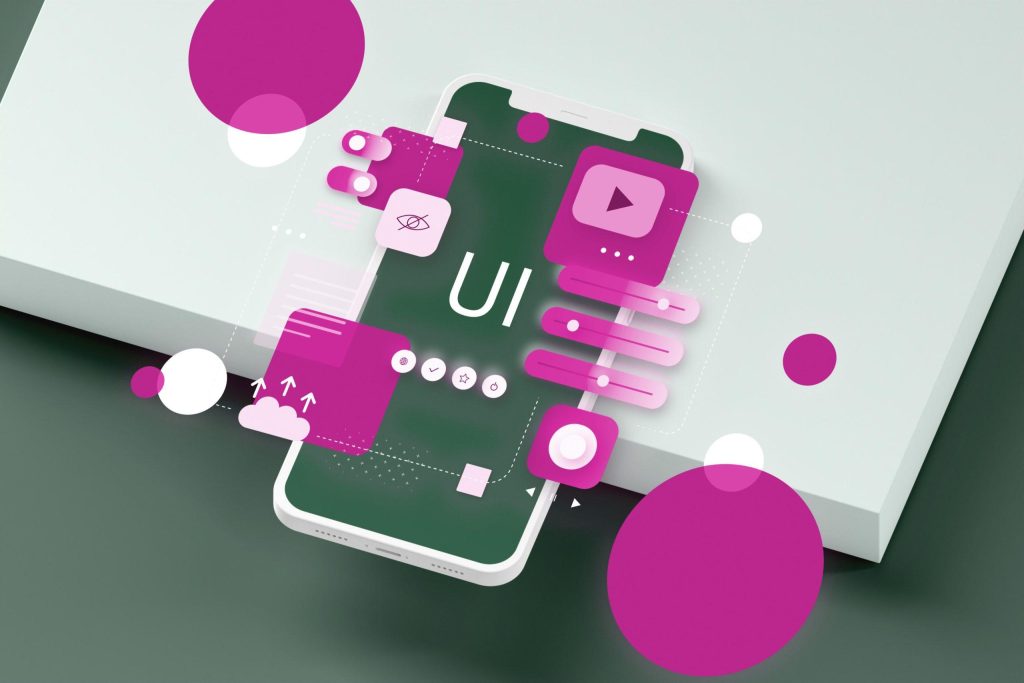At Panalinks, we understand the critical importance of UI/UX design in modern apps, and our team specializes in creating seamless and engaging experiences across various platforms, including WordPress, Laravel, Shopify, and React Native.
In the rapidly evolving digital landscape, the design of user interfaces (UI) and the overall user experience (UX) play a pivotal role in the success of any application. Whether it’s a website, a mobile app, or an e-commerce platform, an intuitive and aesthetically pleasing design can significantly impact user satisfaction and engagement.

UX (User Experience) design focuses on the overall feel of the user’s experience. It encompasses everything from how easy and intuitive an application is to navigate to how satisfying it is to interact with its features. UI (User Interface) design, on the other hand, involves the specific elements that users interact with, including buttons, sliders, and other visual elements. While UX design aims to create a logical, user-friendly path through an application, UI design ensures that the path is visually appealing and enjoyable.
The Impact of Good UI/UX Design

- Enhanced User Satisfaction
A well-designed app can greatly enhance user satisfaction by making interactions smoother and more intuitive. Users are more likely to stay engaged with an app that is easy to navigate and visually appealing. For instance, in e-commerce development, a streamlined checkout process and clear product displays can lead to higher conversion rates and customer retention. - Increased User Engagement
User engagement is crucial for the success of any app. By incorporating effective UI/UX design, you can create a more engaging and interactive experience for users. Features like responsive design, intuitive navigation, and interactive elements can keep users coming back. For example, a Shopify eCommerce site with an engaging interface can encourage users to explore more products and make purchases. - Higher Conversion Rates
For businesses focused on online selling, the primary goal is often to convert visitors into customers. Good UI/UX design can significantly boost conversion rates by reducing friction points in the user journey. Whether it’s a seamless signup process or an easy-to-navigate product catalog, thoughtful design elements can guide users toward completing desired actions. - Competitive Advantage
In today’s crowded market, having a standout app is essential. A well-designed UI/UX can set your app apart from the competition. Users are more likely to choose and remain loyal to apps that offer superior experiences. For instance, in WordPress development, a custom-designed theme with a unique and user-friendly interface can make a significant difference in attracting and retaining users.
Key Elements of Effective UI/UX Design

- User Research and Analysis
Understanding your target audience is the foundation of effective UI/UX design. Conducting user research and analyzing user behavior can provide valuable insights into what users need and expect. This information can then be used to design features and interfaces that meet those needs. - Consistent and Intuitive Navigation
Navigation is a crucial aspect of UI/UX design. Users should effortlessly locate what they need without experiencing confusion or frustration. Consistent navigation menus, clear labels, and logical flow can enhance the user experience. - Responsive Design
With the increasing use of mobile devices, ensuring that your app is responsive is more important than ever. Responsive design allows your app to adapt to different screen sizes and devices, providing a seamless experience for users, whether they are on a desktop, tablet, or smartphone. This is particularly important in React Native app development, where the goal is to create apps that work smoothly across multiple platforms. - Visual Hierarchy
Effective use of visual hierarchy can guide users through your app in a way that makes sense and feels natural. By prioritizing certain elements through size, color, and placement, you can draw users’ attention to the most important features and actions. - Aesthetic Appeal
While functionality is crucial, the visual appeal of your app should not be overlooked. An attractive design can create a positive first impression and make the app more enjoyable to use. This involves choosing the right color schemes, fonts, and imagery to create a cohesive and pleasing look. - Feedback and Iteration
UI/UX design is an ongoing process. Gathering feedback from users and continuously iterating on the design can help you identify areas for improvement and keep the app aligned with user needs and expectations.
The Role of UI/UX Design in E-Commerce Development
In e-commerce development, UI/UX design is particularly important. The success of an e-commerce platform depends largely on how easy and enjoyable it is for users to browse products, make purchases, and complete transactions. Here are some specific ways UI/UX design impacts e-commerce:
Simplified Checkout Process
One of the most critical aspects of an e-commerce site is the checkout process A complex or time-consuming checkout process can result in customers abandoning their carts. By designing a simple, intuitive checkout process, you can reduce friction and increase the likelihood of completed transactions.
Clear Product Presentation
How products are presented can influence purchasing decisions. High-quality images, detailed descriptions, and clear pricing information can help users make informed decisions. Additionally, features like zoom functionality and 360-degree views can enhance the shopping experience.
Personalization
Personalization can significantly improve the user experience in e-commerce. By using data to understand user preferences and behavior, you can offer personalized recommendations and targeted promotions. This improves the overall user experience and significantly boosts the likelihood of conversions.
Trust and Security
Trust is paramount in e-commerce. Users must feel assured that their personal and payment information is protected. UI/UX design plays a role in building this trust through the use of secure payment gateways, clear privacy policies, and trust signals like customer reviews and ratings.
How UI/UX Design Can Generate Better ROI for Your Business
In today’s digital-first world, the design of your user interface (UI) and the overall user experience (UX) is more critical than ever. Effective UI/UX design is not just about aesthetics; it is a strategic investment that can significantly impact your bottom line. By improving usability, enhancing user satisfaction, and optimizing user flows, good UI/UX design can generate a better return on investment (ROI) for your business. Here’s how:
- Increased User Engagement
One of the most immediate benefits of investing in quality UI/UX design is increased user engagement. A well-designed interface that is intuitive and easy to navigate encourages users to spend more time on your platform. When users can find what they are looking for quickly and effortlessly, they are more likely to explore more pages, interact with more content, and ultimately convert.
Case Study: E-commerce Platforms
For e-commerce sites, this could mean users browsing through more products and making additional purchases. Effective UI/UX design elements such as clear call-to-action buttons, easy-to-use navigation menus, and streamlined checkout processes can significantly enhance the shopping experience, leading to higher sales and repeat business.
- Improved Conversion Rates
Good UI/UX design is directly linked to improved conversion rates. When users have a positive experience on your site or app, they are more likely to complete the desired actions, whether that’s making a purchase, signing up for a newsletter, or filling out a contact form. Simplifying the user journey and reducing friction points can lead to higher conversion rates.
Example: Landing Pages
Optimizing landing pages for clarity and ease of use can make a big difference. Clear, concise messaging, compelling visuals, and strategically placed call-to-action buttons can guide users towards taking the next step. By reducing the number of steps and making the process as intuitive as possible, you can significantly boost your conversion rates.
- Enhanced Customer Satisfaction and Loyalty
A positive user experience contributes to increased customer satisfaction. When users find your platform easy and enjoyable to use, they are more likely to return. Repeat customers are invaluable, as they tend to spend more and are more likely to recommend your business to others.
Impact on Brand Loyalty
Building a loyal customer base through excellent UI/UX design can have a long-term impact on your business. Satisfied customers are more likely to become brand advocates, sharing their positive experiences with friends and family. This word-of-mouth marketing can drive new customers to your business at no additional cost.
- Reduced Development Costs
Investing in UI/UX design early in the development process can actually save you money in the long run. Identifying and addressing usability issues during the design phase is much cheaper than making changes after the product has been launched. Good UI/UX design practices involve thorough user testing and feedback loops, which can help you catch potential problems before they become costly fixes.
Efficient Development Process
A well-thought-out design can streamline the development process by providing clear guidelines and specifications. This reduces the likelihood of miscommunication and ensures that developers have a clear understanding of what needs to be built, leading to fewer revisions and less rework.
- Increased Accessibility
A key aspect of good UI/UX design is making your platform accessible to all users, including those with disabilities. By adhering to accessibility best practices, you can reach a broader audience and ensure that everyone can use your platform effectively.
Legal and Ethical Considerations
Beyond the moral imperative to make your site accessible, there are also legal considerations. Many countries have regulations requiring digital accessibility. Investing in accessible design can help you avoid potential legal issues and fines, while also demonstrating your commitment to inclusivity.
- Better Data-Driven Decisions
Effective UI/UX design involves continuous testing and optimization. By collecting and analyzing data on how users interact with your platform, you can make informed decisions about how to improve the user experience. Tools like heatmaps, user session recordings, and A/B testing can provide valuable insights into user behavior.
Continuous Improvement
This data-driven approach allows for continuous improvement of your platform. By regularly updating and refining the design based on user feedback and behavior, you can keep your platform relevant and effective, ensuring ongoing user satisfaction and high ROI.
- Competitive Advantage
In a saturated market, distinguishing yourself from competitors is imperative. Superior UI/UX design can give you a competitive edge by differentiating your platform from others. When users compare your site or app to others, a better design can be the deciding factor in choosing your platform over competitors.
Branding and Perception
A well-designed platform also contributes to your overall brand perception. It shows that you value your users and are committed to providing them with the best possible experience. This can enhance your brand reputation and attract more customers.
Maximizing Revenue Through Enhanced UI/UX Design: Strategies for Billing More for Your Work

In the competitive landscape of digital design, maximizing revenue often hinges on the value you deliver to clients. Superior UI/UX design is not only about crafting visually appealing and intuitive interfaces; it’s about providing tangible benefits that justify higher billing rates. Here’s how you can leverage improved UI/UX design to bill more for your work:
- Demonstrate Value with Data
- Enhanced User Engagement: One of the most compelling arguments for better UI/UX design is the direct impact on user engagement. By presenting data that shows how enhanced design increases time spent on a site, reduces bounce rates, and boosts interactions, you can make a strong case for the value of your work. For instance, if redesigning a client’s website led to a 40% increase in user engagement, you have concrete evidence to support higher fees.
- Conversion Rate Optimization: UI/UX design plays a crucial role in optimizing conversion rates. Use analytics to showcase how your design improvements have led to higher conversion rates. This could include more sign-ups, purchases, or inquiries. Highlighting these metrics can justify a premium for your services.
- Offer Comprehensive Services
- End-to-End Solutions: Offering end-to-end UI/UX services—from initial research and user testing to design implementation and post-launch analysis—allows you to charge more by providing a complete package. Clients often prefer to work with a single provider who can handle all aspects of their design needs, and this convenience can command higher rates.
- Specialized Expertise: Position yourself as an expert in specific areas of UI/UX design, such as accessibility, mobile-first design, or e-commerce optimization. Specialized expertise often warrants higher fees because it addresses niche needs that require advanced knowledge and skills.
- Highlight the ROI of Good Design
- Increased Revenue: Illustrate how improved UI/UX design directly impacts a client’s bottom line. For example, better design can lead to increased sales and higher average order values. Use case studies and client testimonials to demonstrate how your work has resulted in significant financial gains for previous clients.
- Cost Savings: Good design reduces the need for frequent changes and redesigns, saving clients money in the long run. Emphasize how your thorough design process, which includes extensive user testing and feedback loops, minimizes costly post-launch fixes and iterations.
- Create a Differentiated Pricing Model
- Value-Based Pricing: Instead of billing purely by the hour, consider value-based pricing. This involves setting fees based on the value you provide to the client rather than the time spent on the project. If your design work is expected to generate substantial revenue or savings for the client, value-based pricing can significantly increase your billing rates.
- Tiered Service Packages: Offer tiered service packages that provide different levels of design services. For example, a basic package could include essential UI/UX design, while a premium package might offer additional services like in-depth user research, advanced prototyping, and ongoing support. This approach allows clients to choose the level of service that best fits their needs and budget, with higher tiers justifying higher fees.
- Enhance Your Professional Image
- Portfolio and Case Studies: Build a strong portfolio showcasing your best work and include detailed case studies that outline the challenges, your design solutions, and the positive outcomes. A robust portfolio demonstrates your expertise and the tangible benefits of your work, making it easier to justify higher rates.
- Certification and Continuing Education: Invest in certifications and continuous learning in UI/UX design. Credentials from recognized institutions add credibility to your expertise and justify premium pricing. Clients are often willing to pay more for designers who are certified experts in their field.
- Focus on Long-Term Client Relationships
- Ongoing Maintenance and Support: Offer ongoing maintenance and support packages. This not only provides additional revenue streams but also reinforces the value of your work by ensuring the client’s site remains updated and optimized. Long-term relationships often lead to steady, higher billing over time.
- Client Education: Educate your clients on the importance of UI/UX design and how it affects their business outcomes. By positioning yourself as a partner in their success, rather than just a service provider, you can build trust and justify higher fees.
- Emphasize Custom Solutions
- Tailored Designs: Highlight the bespoke nature of your design services. Custom solutions tailored to the unique needs of each client often command higher fees than generic templates. Emphasize the bespoke nature of your work and how it addresses specific client challenges and goals.
- Competitive Advantage: Show clients how superior UI/UX design gives them a competitive edge in their industry. Whether it’s through unique, user-friendly interfaces or innovative features that set them apart from competitors, your custom solutions can justify a premium price.
Conclusion

In the digital age, UX/UI design is not just about making an app look good; it’s about creating meaningful and enjoyable experiences for users. Whether you are developing a website, an e-commerce platform, or a mobile app, investing in good UX/UI design can lead to higher user satisfaction, increased engagement, and better conversion rates. Incorporating superior UI/UX design into your offerings can significantly enhance the perceived and actual value of your work, allowing you to bill more for your services.
By demonstrating the direct benefits of your design, offering comprehensive and specialized services, and positioning yourself as a knowledgeable and valuable partner, you can justify higher rates and achieve better financial outcomes for your business. At Panalinks, we specialize in creating exceptional user experiences across various platforms, including WordPress, Laravel, Shopify, and React Native. Our team of experts is dedicated to helping you achieve your business goals through innovative and user-centric design.
If you have any questions or would like to learn more about our UX/UI design services, please write to us at contactus@panalinks.com. Let us help you revolutionize your digital presence with outstanding design.

